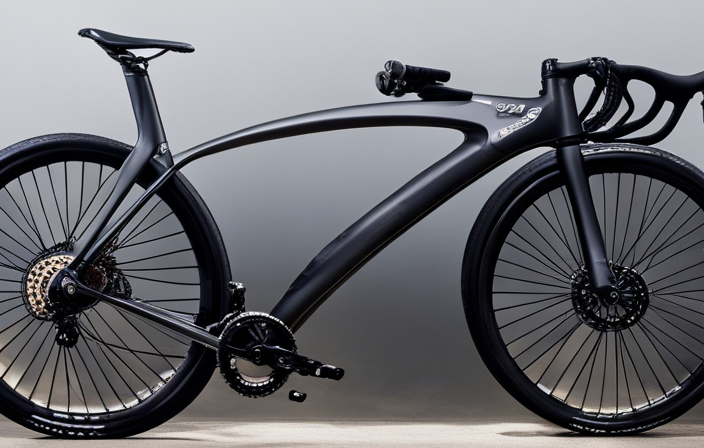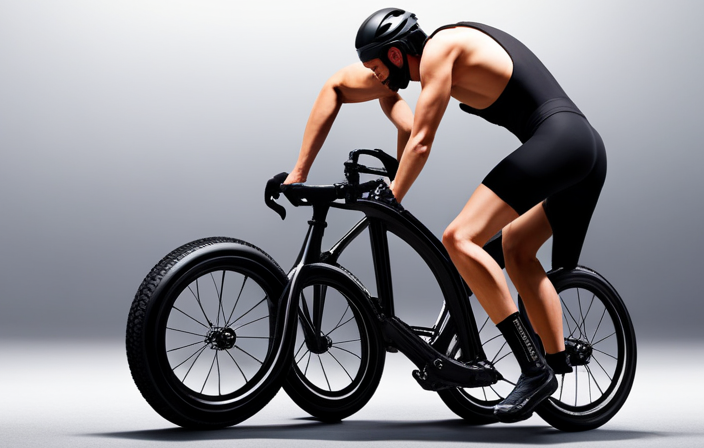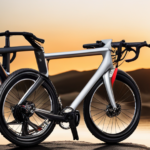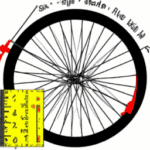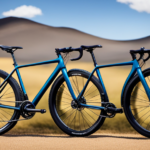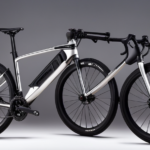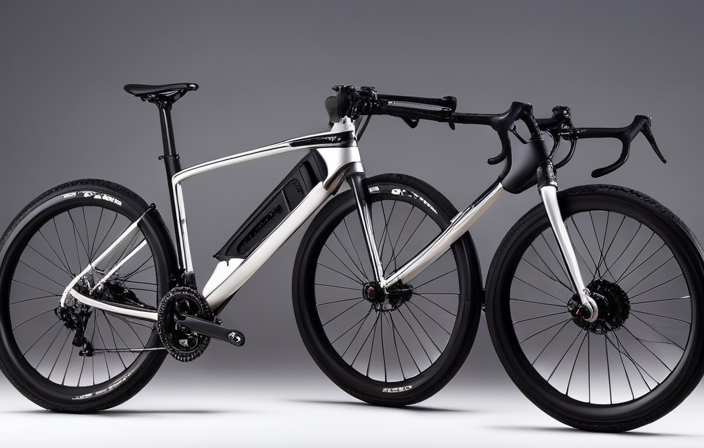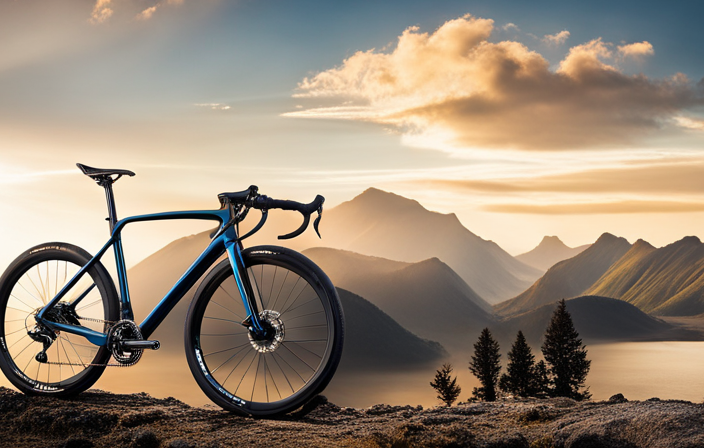Fed up with your gravel bike tires always scraping against the frame, putting a damper on your off-road excursions? Search no more!
In this informative article, I will delve into the intricate world of tire clearance for gravel bikes. From understanding its importance in off-road cycling to finding the right balance between clearance and performance, I will guide you through the process of determining just how much tire clearance your trusty steed needs.
Get ready to upgrade your gravel biking experience with optimal tire clearance.
Key Takeaways
- Tire clearance is important for determining tire width and affects bike performance and comfort.
- Having adequate tire clearance allows for larger tires at lower pressures, improving grip on uneven surfaces and enhancing comfort and shock absorption.
- The appropriate tire clearance varies depending on the rider’s skill level, with different recommendations for beginners, intermediate riders, and advanced riders.
- Different terrains also require different tire clearances, and adjusting tire pressure and finding suitable tire width can enhance performance and control on specific terrains.
Understanding Tire Clearance for Gravel Bikes
You’ll want to understand how much tire clearance your gravel bike has. Finding the ideal tire width is crucial for off-road cycling, as it affects your bike’s performance and comfort. Different gravel bike models offer varying levels of tire clearance, so it’s essential to compare them before making a decision.
Tire clearance refers to the space between your bike frame and the tires. It determines how wide of a tire you can fit on your bike without causing any issues such as rubbing or decreased handling. To find the ideal tire width, measure the distance between the stays (the frame tubes that connect the rear wheel) and forks (the front part of your bike). This will give you an idea of how much space you have for wider tires.
When comparing tire clearance on different gravel bike models, pay attention to both the rear and front clearances. Some bikes may have more room in one area than the other, limiting your options for tire width. Additionally, consider factors like mud buildup or debris accumulation which can affect tire clearance while riding off-road.
Understanding your gravel bike’s tire clearance is vital because it directly impacts your ability to traverse various terrains comfortably and safely. With proper knowledge of your bike’s limitations, you can confidently choose suitable tires that will enhance your off-road cycling experience.
Now let’s explore why tire clearance is so important in off-road cycling.
The Importance of Tire Clearance in Off-Road Cycling
Having ample space for larger tires is crucial for optimal performance when riding off-road. Understanding tire pressure and the benefits of tubeless tires are essential in appreciating the importance of tire clearance in off-road cycling.
-
Tubeless tires: One major benefit of tubeless tires is their ability to run at lower pressures without risking pinch flats. This allows for better traction and a smoother ride over rough terrain.
-
Improved grip: With lower tire pressure, the tire conforms better to uneven surfaces, increasing contact patch and enhancing grip. This is especially beneficial on loose gravel or muddy trails.
-
Enhanced comfort: Lower pressures also provide greater shock absorption, reducing fatigue during long rides. The ability to absorb bumps and vibrations translates into a more comfortable experience on challenging terrains.
Considering these factors, it becomes clear that sufficient tire clearance is essential for off-road cycling. Not only does it allow for larger tires that can handle lower pressures, but it also improves grip and comfort on rough terrains.
In the next section, we will discuss the factors to consider when determining tire clearance without compromising performance.
Factors to Consider When Determining Tire Clearance
When considering tire clearance, it’s important to take into account the terrain you’ll be riding on and the type of riding you plan to do. Adjusting tire pressure is one factor that can greatly impact your ride. Lowering the tire pressure allows for better traction and a smoother ride on rough surfaces like gravel or dirt. However, if you’re planning on riding mostly on paved roads, higher tire pressure will provide less rolling resistance and a faster ride.
Another important factor to consider is the impact of tire width. Wider tires offer more stability and control when riding off-road, as they have a larger contact patch with the ground. They also provide better grip in loose or slippery conditions. On the other hand, narrower tires are more aerodynamic and lighter, making them ideal for faster rides on smooth surfaces.
Finding the right balance between tire clearance and performance is crucial. While wider tires may offer better traction and control off-road, they can also slow you down on pavement due to increased rolling resistance. It’s important to find a tire width that suits your specific needs and preferences.
Transitioning into the subsequent section about ‘finding the right balance: clearance vs. performance’, it’s essential to understand how these factors play a role in determining the optimal clearance for your gravel bike setup without compromising its overall performance.
Finding the Right Balance: Clearance vs. Performance
To achieve optimal performance, it’s important to strike the right balance between clearance and how well your bike performs. When considering tire clearance for a gravel bike, there are several factors that come into play. Here, I will outline four key considerations to help you understand the relationship between clearance and performance.
-
Clearance vs. Stability: A larger tire clearance allows for bigger tires, which can provide more stability on rough terrain. However, too much clearance can negatively affect handling and make the bike feel less responsive.
-
Tire Clearance and Weight Distribution: The amount of tire clearance affects the overall weight distribution of the bike. A wider tire requires more space in the frame and fork, potentially shifting weight towards the rear or front of the bike.
-
Handling Characteristics: Tire clearance also impacts how a bike handles in different conditions. Narrower tires offer better maneuverability on smooth surfaces, while wider tires excel in loose or muddy terrain.
-
Trade-offs: It’s essential to consider trade-offs when choosing tire clearance. More clearance may allow for larger tires and improved comfort but could lead to slower speeds on pavement.
Understanding these factors will help you find the right balance between tire clearance and performance for your gravel riding needs. Transitioning into our next section about recommended tire clearances for beginner gravel riders…
Recommended Tire Clearance for Beginner Gravel Riders
For beginner riders looking to explore gravel terrain, it is recommended to start with a tire clearance that allows for greater stability and improved handling. When determining the appropriate tire clearance for your gravel bike, there are several measuring techniques you can use. One method is to measure the distance between the center of your bottom bracket and the closest point on your tire. Another technique involves measuring the space between your fork or rear chainstays and the widest part of your tire. These measurements will give you an idea of how much clearance you have and what size tires you can comfortably fit on your bike.
Adjusting tire pressure is another important factor in achieving optimal performance on gravel surfaces. Lowering your tire pressure can provide better traction and a smoother ride by allowing the tires to conform to uneven terrain. However, it’s crucial not to go too low as this can increase the risk of pinch flats or damaging your rims.
As a beginner gravel rider, having enough tire clearance and properly adjusted tire pressure will enhance your overall riding experience. This combination offers increased stability while navigating rough terrains and improves handling when encountering loose surfaces. Transitioning into the subsequent section about optimal tire clearance for intermediate gravel riders, it’s essential to further refine these factors for more advanced riding capabilities.
Optimal Tire Clearance for Intermediate Gravel Riders
Having enough space between the frame and the widest part of your tire is crucial for intermediate gravel riders looking to enhance their riding capabilities. When it comes to finding the right tire size, there are a few factors to consider.
Firstly, you need to ensure that your tires have enough clearance so that they don’t rub against the frame or fork when riding over rough terrain. This can cause damage to both the tire and the bike, as well as impact your ability to control the bike effectively.
Additionally, tire pressure plays a significant role in determining tire clearance. Lowering your tire pressure can increase the width of your tires slightly, which may affect clearance. It’s important to strike a balance between finding a comfortable tire pressure for your riding style and maintaining adequate clearance.
For intermediate gravel riders, I recommend aiming for around 40-45mm of tire clearance. This will allow you to use wider tires that provide better traction and stability on loose surfaces without compromising bike handling or risking damage to your bike.
Transitioning into advanced tire clearance for experienced gravel riders, it becomes even more crucial to find optimal clearance as these riders tend to push their limits on more challenging terrains without sacrificing control and performance.
Advanced Tire Clearance for Experienced Gravel Riders
Transitioning from the previous subtopic, where we discussed the optimal tire clearance for intermediate gravel riders, let’s now focus on advanced tire clearance for experienced gravel riders. As an experienced rider myself, I understand the importance of fine-tuning your bike to achieve peak performance on challenging terrains.
When it comes to tire clearance for advanced gravel riding, there are a few key factors to consider. First and foremost is optimal tire pressure. Adjusting the pressure according to the terrain can significantly impact your ride quality and overall control. Lower pressures provide better traction and shock absorption on rough surfaces, while higher pressures minimize rolling resistance on smoother sections.
Secondly, exploring different tire width options becomes crucial at this level. A wider tire offers increased stability and grip on loose or uneven surfaces, allowing you to confidently navigate through challenging conditions. Additionally, wider tires have a larger air volume which contributes to enhanced comfort during long rides.
To summarize:
- Optimal tire pressure: Adjusting according to terrain improves control.
- Tire width options: Wider tires enhance stability and grip.
- Improved traction: Lower pressures offer better traction on rough surfaces.
- Enhanced comfort: Wider tires with larger air volume provide added comfort.
Considering these factors will help advanced gravel riders optimize their bike setup for superior performance on any trail or road condition.
Now let’s delve into how tire clearance impacts ride quality in our next section.
The Impact of Tire Clearance on Ride Quality
To improve your ride quality, it’s important to understand how tire clearance can impact your overall experience. The influence of tire pressure on ride quality cannot be underestimated. By having an adequate tire clearance, you allow for the optimal amount of air in your tires, which directly affects the comfort and performance of your gravel bike. With the right tire pressure, you can cushion against bumps and vibrations while maintaining traction on various surfaces.
Additionally, tire tread plays a crucial role in gravel bike performance. The pattern and depth of the tread determine how well your bike grips the ground. A more aggressive tread is ideal for loose or muddy terrains as it provides better traction and prevents slippage. On the other hand, a smoother tread pattern reduces rolling resistance on hard-packed surfaces.
By considering both tire pressure and tread, you can fine-tune your gravel bike’s ride quality to suit different terrains. Adjusting tire clearance allows you to switch between tires with varying widths and treads based on the conditions you anticipate encountering during your rides. This adaptability enhances your biking experience by ensuring optimal grip and comfort throughout your adventures without compromising speed or control.
Adjusting Tire Clearance for Different Terrains
Adjusting your tire clearance can greatly enhance your riding experience on various terrains. One important aspect to consider is adjusting the tire pressure. Different terrains require different levels of tire pressure for optimal performance. For example, when riding on rough and rocky trails, it is beneficial to lower the tire pressure to increase traction and absorb shocks. On the other hand, when riding on smoother surfaces like pavement or hard-packed gravel, higher tire pressures improve rolling efficiency.
Another factor to consider is the type of tire tread that suits different terrains. For loose gravel or muddy conditions, a tire with more aggressive knobs and wider spacing between them provides better grip and prevents mud from getting stuck in between. Conversely, for smoother surfaces or paved roads, a slick or semi-slick tread pattern with minimal knobs reduces rolling resistance and maximizes speed.
By adjusting both tire pressure and tread according to the terrain you plan to ride on, you can optimize your bike’s performance and ensure a comfortable ride.
Now that we understand the importance of adjusting tire clearance for different terrains, let’s dive into how to measure tire clearance on your gravel bike without any additional steps.
How to Measure Tire Clearance on Your Gravel Bike
To measure the clearance of your tires on a gravel bike, you can use a ruler or caliper to determine the space between the tire and various parts of the frame. Start by measuring the distance between the top of the tire and the closest part of your frame, such as the fork crown or seat stays. This will give you an idea of how much vertical clearance you have.
Next, measure the distance between the widest point of your tire and any part of your frame that could come into contact with it, such as chainstays or seat tube. This will help you determine if there is enough horizontal clearance for your tires.
Measuring tire width is crucial because proper tire clearance is essential for optimal performance and safety when riding on different terrains. Insufficient clearance can lead to issues like mud or debris buildup, which can affect traction and handling. On the other hand, excessive clearance may result in reduced stability and potentially damage components if stones or other objects get caught between them.
Having accurate measurements allows you to choose tires that fit well within your bike’s limits while providing sufficient grip and comfort for specific terrain types. Understanding proper tire clearance helps in avoiding potential problems during rides while ensuring an enjoyable experience overall.
With this knowledge about measuring tire clearance, let’s now explore the benefits of wider tire clearance for gravel biking.
The Benefits of Wider Tire Clearance
Having wider clearance for your tires on a gravel bike can enhance your riding experience in various ways. The benefits of wider tire clearance include improved traction, increased stability, and enhanced comfort.
| Benefits of Wider Tire Clearance | |
|---|---|
| 1. Improved Traction | Wider tires provide a larger contact patch with the ground, resulting in better grip and traction on loose surfaces like gravel or dirt roads. This allows you to ride with more confidence and control, especially when cornering or braking. |
| 2. Increased Stability | With wider tire clearance, your bike becomes more stable and less prone to swaying or wobbling. This is particularly advantageous when riding over rough terrain or encountering obstacles such as rocks or roots. It helps maintain balance and reduces the risk of accidents or falls. |
| 3. Enhanced Comfort | Wider tires offer greater cushioning and shock absorption capabilities, providing a smoother ride even on bumpy surfaces. They can effectively dampen vibrations and reduce fatigue during long rides, allowing you to enjoy your gravel adventures for longer periods without discomfort. |
These performance enhancements associated with wider tire clearance come with potential drawbacks of excessive tire clearance that need to be considered for a well-rounded evaluation of its overall impact on your gravel biking experience.
Potential Drawbacks of Excessive Tire Clearance
After discussing the benefits of wider tire clearance for gravel bikes, it is important to also consider the potential drawbacks associated with excessive tire clearance.
While having more tire clearance allows for larger tires, which can improve comfort and traction on rough terrain, there are a few factors that may impact performance.
One potential drawback of excessive tire clearance is increased weight. The larger tires required to fill up the extra space can add significant weight to the bike, which may hinder acceleration and overall speed. Additionally, excessively wide tires can create a less efficient rolling resistance on smoother surfaces, such as pavement or hard-packed dirt.
Another consideration is the effect of wider tires on handling and maneuverability. Bikes with excessive tire clearance may feel less nimble and responsive compared to those with narrower tires. This could be particularly noticeable when navigating tight corners or technical sections of a trail.
Despite these potential drawbacks, many riders still prefer wider tire clearance for its enhanced traction and comfort off-road. However, finding a balance between tire size and frame compatibility is crucial to optimize both performance and ride quality.
Now let’s delve into the topic of tire clearance and frame compatibility in greater detail…
Tire Clearance and Frame Compatibility
When considering tire clearance and frame compatibility, you should prioritize finding a balance that optimizes both performance and ride quality. Understanding frame compatibility is crucial in ensuring that your tires fit properly within the bike’s frame without any interference or rubbing. It is important to consult your bike manufacturer’s guidelines or seek advice from a professional to determine the maximum tire width that your specific frame can accommodate.
Tire pressure also plays a significant role in tire clearance. Higher tire pressures can reduce the overall volume of the tire, allowing for more clearance between the tire and the frame. However, it is essential to strike a balance with tire pressure as excessively high pressures can result in reduced traction and a harsher ride quality.
Finding the right combination of tire width and pressure will ensure optimal performance on various terrains while maintaining adequate clearance within your bike’s frame.
As we move into discussing upgrading your gravel bike’s tire clearance, it is essential to consider factors such as rim width, fork and rear triangle design, and brake caliper compatibility. These aspects will play a crucial role in determining how much additional tire clearance you can achieve without compromising safety or functionality.
Upgrading Your Gravel Bike’s Tire Clearance
To upgrade your gravel bike’s tire clearance, there are a few factors to consider. Firstly, rim width plays a crucial role. Wider rims provide better support and stability, allowing for larger tires to be installed. Secondly, the design of the fork and rear triangle should have sufficient space to prevent any interference between the tire and frame during operation.
Brake caliper compatibility is another important consideration. Disc brakes are commonly used on gravel bikes, but certain calipers may limit the available tire clearance. It is important to ensure that your chosen calipers are compatible with both the desired tire size and rim width.
Once you have upgraded your bike’s tire clearance, there are a few additional considerations to keep in mind. Finding optimal tire pressure is crucial for maximizing performance and comfort on different terrain types. Experimenting with different pressures will help you find the sweet spot that offers both grip and efficiency.
Additionally, consider switching to tubeless tires for their numerous benefits. Tubeless setups allow you to run lower pressures without risking pinch flats or punctures from thorns or sharp objects commonly encountered while riding off-road.
In conclusion, upgrading your gravel bike’s tire clearance involves considering factors such as rim width, fork and rear triangle design, and brake caliper compatibility. Once upgraded, finding optimal tire pressure and considering tubeless setups can further enhance your riding experience.
Final Thoughts: Finding the Perfect Tire Clearance for Your Gravel Bike
In conclusion, it’s important to find the optimal tire clearance for your gravel bike in order to maximize performance and comfort on various terrains. Finding the right tire width is crucial as it directly affects how your bike handles different surfaces. However, there is a trade-off between tire clearance and weight that needs to be considered.
Here are five key points to keep in mind when finding the perfect tire clearance:
-
Terrain: Consider the types of terrain you will be riding on. If you frequently encounter rough or loose surfaces, a wider tire with more clearance would be beneficial for better traction and stability.
-
Comfort: A larger tire with greater clearance can provide added cushioning and absorb shocks, resulting in a smoother ride.
-
Handling: Narrower tires offer better agility and responsiveness, making them ideal for twisty or technical trails. However, they may compromise stability on looser surfaces.
-
Weight: Remember that increasing tire width also means adding more weight to your bike. This can impact acceleration and overall performance, especially during climbs.
-
Frame compatibility: Ensure that your frame has enough clearance to accommodate wider tires without rubbing against the frame or fork.
By considering these factors and striking the right balance between tire clearance and weight, you can enhance both performance and comfort on your gravel bike across a variety of terrains.
Frequently Asked Questions
Can I use a mountain bike tire on my gravel bike?
Yes, gravel bike tires can be used on mountain bikes as long as the tire size and rim width are compatible.
However, it’s important to note that gravel bike tires are typically designed for smoother surfaces and may not provide optimal performance on rougher terrain.
When it comes to tire pressure, lower pressures generally offer better traction on loose surfaces like gravel, while higher pressures increase efficiency on pavement.
Adjusting tire pressure accordingly can greatly enhance a gravel bike’s performance across different terrains.
What are the advantages of wider tire clearance?
Having wider tire clearance on a gravel bike has several advantages.
Firstly, it allows for the use of larger tires, which can provide increased comfort and stability on rough terrain.
Additionally, wider tire clearance allows for better mud and debris clearance, reducing the risk of clogging and improving traction.
On the other hand, narrower tire clearance may result in limited tire options and reduced off-road performance.
Overall, wider tire clearance offers greater versatility and enhanced riding experience on a gravel bike.
How does tire clearance affect the overall performance of a gravel bike?
Tire clearance greatly affects the overall performance of a gravel bike. A larger tire clearance allows for wider tires to be fitted, which can enhance both bike handling and ride comfort.
With more clearance, there is reduced risk of mud or debris getting stuck between the tire and frame, ensuring smoother rides on rough terrain. Additionally, wider tires provide increased traction and stability, improving control and maneuverability while navigating gravel surfaces.
Are there any drawbacks to having excessive tire clearance?
Excessive tire clearance on a gravel bike has its pros and cons.
On the positive side, it allows for the use of wider tires, which enhances traction and stability on rough terrains. This can improve overall performance, especially in off-road conditions.
However, there are drawbacks to consider as well. Excessive tire clearance may compromise the frame’s durability due to increased stress placed on the structure.
Thus, finding a balance between tire clearance and bike durability is crucial for optimal gravel biking experience.
Can I adjust the tire clearance on my gravel bike to accommodate different terrains?
Yes, it’s possible to adjust the tire clearance on a gravel bike to accommodate different terrains. By adjusting the tire clearance, you can optimize the tire width for gravel biking.
This allows you to switch between narrower tires for smoother surfaces and wider tires for rougher terrain. It’s important to find the optimal tire width that balances traction and rolling resistance based on your preferred riding conditions.
Conclusion
In conclusion, determining the right tire clearance for your gravel bike is crucial in achieving optimal performance and comfort on off-road terrains.
It is recommended that beginner gravel riders opt for a tire clearance of around 40mm to strike a balance between stability and speed.
Interestingly, studies have shown that increasing tire clearance by just 10mm can significantly improve traction and control, allowing riders to confidently tackle rougher surfaces with ease.
So make sure to consider these factors when upgrading or selecting a new gravel bike for an enhanced cycling experience.
